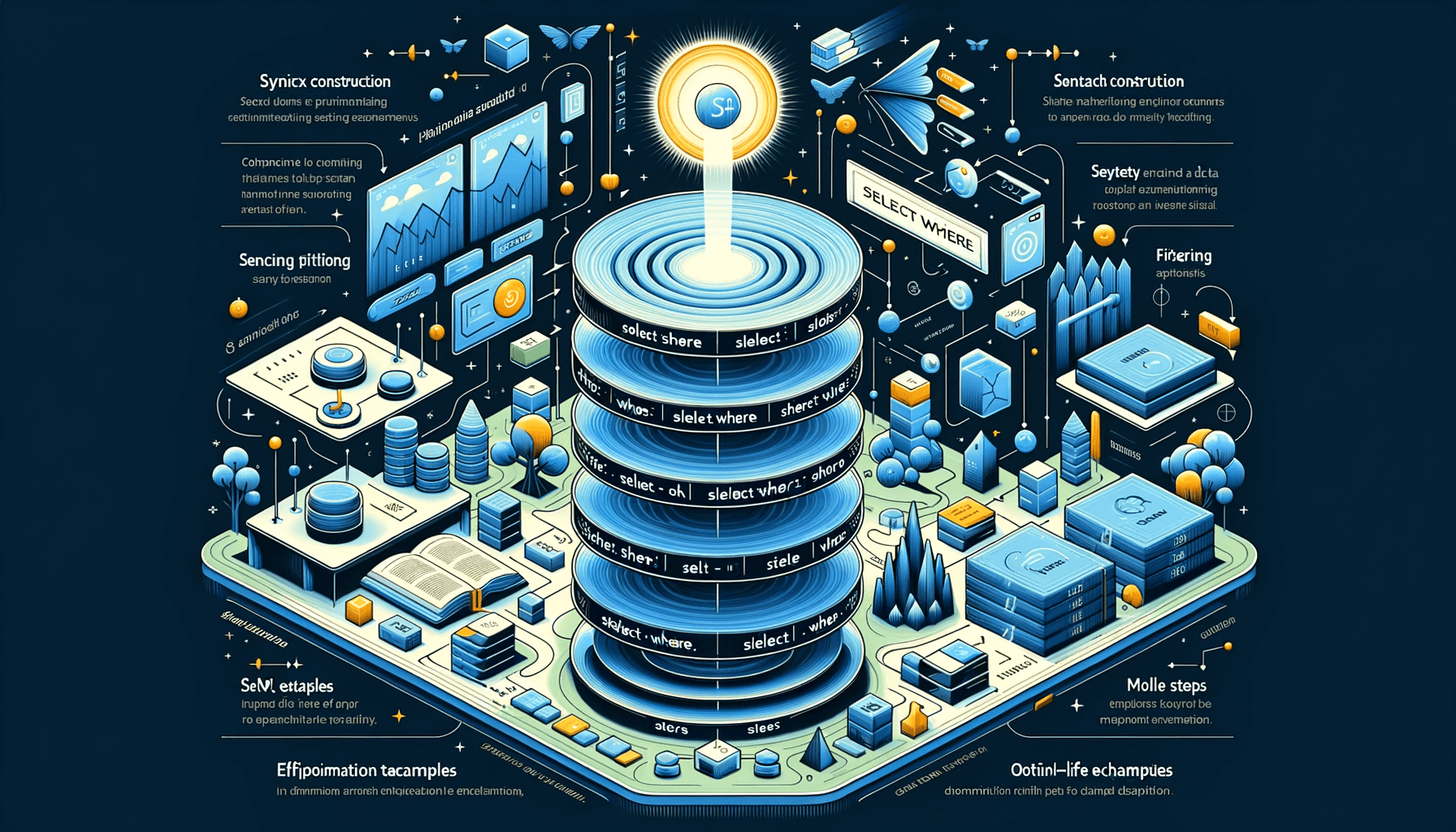A big variety of articles and resources

Mastering SQL Developer: Tips and Tricks for Efficient Database Management
 Sia Author and Instructor
Learn SQL
Sia Author and Instructor
Learn SQL
15 minute read
Mastering SQL Developer is key to efficient database management. This article shares tips and tricks to help you become an expert in SQL development. Whether you're just starting or looking to sharpen your skills, these insights will guide you through advanced techniques, performance optimization, and best practices.
Key Takeaways
- Understand the core responsibilities and skills of an SQL developer.
- Learn advanced SQL query techniques like subqueries and CTEs.
- Discover strategies to optimize SQL query performance.
- Get insights into database schema design and management.
- Explore security best practices for SQL developers.
Understanding the Role of an SQL Developer
Key Responsibilities and Skills
As an SQL Developer, I handle various tasks that are crucial for managing databases. My main responsibilities include writing and optimizing SQL queries, designing database schemas, and ensuring data integrity. Being proficient in SQL is essential for this role. I also need to be familiar with different database management systems like MySQL, PostgreSQL, and SQL Server. Additionally, I must have strong problem-solving skills to troubleshoot and resolve database issues effectively.
Importance in Modern Data Management
In today's data-driven world, SQL Developers play a vital role. We ensure that data is stored efficiently and can be retrieved quickly. This is important for businesses that rely on data for decision-making. By optimizing queries and managing databases, we help improve the performance of applications and systems. Our work directly impacts the speed and reliability of data access, which is crucial for any organization.
Career Pathways and Opportunities
The career path for an SQL Developer is promising. Starting as a junior developer, I can advance to senior roles and eventually become a database administrator or a data architect. There are also opportunities to specialize in areas like data warehousing or business intelligence. The demand for SQL Developers is high, and mastering these skills can open doors to various career opportunities in the tech industry.
Mastering SQL Developer skills is not just about writing queries; it's about understanding how to manage and optimize databases effectively.
Advanced SQL Query Techniques
Subqueries and Nested Queries
Subqueries, also known as inner queries, are queries within another SQL query. They allow you to perform complex operations in a step-by-step manner. Nested queries can be used in SELECT, INSERT, UPDATE, or DELETE statements. Mastering these advanced SQL functions and techniques will significantly enhance your ability to manage and analyze data effectively.
Benefits of subqueries:
- Break down complex queries into simpler parts.
- Improve readability and maintainability of SQL code.
Common Table Expressions (CTEs)
Common Table Expressions (CTEs) are temporary result sets that you can reference within a SELECT, INSERT, UPDATE, or DELETE statement. They make your SQL code more readable and easier to manage. CTEs are especially useful for recursive queries, which are queries that refer to themselves.
Window Functions and Their Applications
Window functions perform calculations across a set of table rows that are somehow related to the current row. Unlike aggregate functions, they do not cause rows to become grouped into a single output row. Instead, the rows retain their separate identities. Window functions are powerful for tasks like running totals, moving averages, and ranking.
Utilizing subqueries and nested queries can break down complex queries into simpler parts, making them easier to understand and maintain.
Optimizing SQL Query Performance
Indexing Strategies
Indexing is a powerful way to speed up your SQL queries. By creating indexes on columns that are frequently used in WHERE clauses, you can significantly reduce the time it takes to retrieve data. However, it's important to balance the number of indexes, as too many can slow down write operations.
Query Execution Plans
Understanding query execution plans is crucial for optimizing performance. These plans show how the SQL engine executes a query, allowing you to identify bottlenecks. Use the EXPLAIN command to view the execution plan and make necessary adjustments.
Performance Tuning Tips
- Avoid using SELECT \*: Specify only the columns you need.
- Use joins instead of subqueries where possible.
- Regularly update statistics to help the SQL engine make better decisions.
- Optimize your database schema to reduce redundancy and improve access times.
Efficient use of indexing strategies, understanding query execution plans, and applying performance tuning tips are essential for mastering SQL query performance. This page focuses on optimizing SQL queries for performance, emphasizing indexing strategies, query execution plans, and efficient use of joins and subqueries.
Database Schema Design and Management
Normalization and Denormalization
When designing a database schema, understanding normalization and denormalization is crucial. Normalization involves organizing data to reduce redundancy and improve data integrity. This process typically includes dividing large tables into smaller, related tables. On the other hand, denormalization is the process of combining tables to improve read performance, often at the cost of write performance.
Entity-Relationship Modeling
Entity-Relationship (ER) modeling is a method used to visually represent the data and its relationships within a database. This technique helps in planning and structuring the database effectively. An ER diagram includes entities (tables), attributes (columns), and relationships (associations between tables).
Schema Version Control
Managing changes to the database schema is essential for maintaining consistency and integrity. Schema version control involves tracking and documenting changes to the database structure over time. Tools like Liquibase and Flyway can automate this process, ensuring that all changes are applied consistently across different environments.
Effective schema design and management are foundational to efficient database operations. By mastering these techniques, you can ensure your database is both robust and scalable.
Ensuring Data Integrity and Consistency
ACID Properties
When working with databases, it's crucial to understand the ACID properties: Atomicity, Consistency, Isolation, and Durability. These properties ensure that database transactions are processed reliably. Atomicity guarantees that all operations within a transaction are completed; if one part fails, the entire transaction fails. Consistency ensures that a transaction can only bring the database from one valid state to another. Isolation means that transactions occur independently without interference. Durability ensures that once a transaction is committed, it will remain so, even in the event of a system failure.
Transaction Management
Transaction management is essential for maintaining data integrity. By grouping multiple operations into a single transaction, you can ensure that either all operations succeed or none do. This is particularly important in scenarios where multiple operations depend on each other. For example, in a banking system, transferring money from one account to another involves debiting one account and crediting another. Both operations must succeed for the transaction to be valid.
Data Validation Techniques
Data validation is a key practice to ensure that the data entered into the database is accurate and consistent. Techniques include using constraints like primary keys, foreign keys, and unique constraints to enforce data rules. Additionally, implementing triggers and stored procedures can help automate validation processes. Regularly auditing and cleaning the data can also help maintain its integrity.
Ensuring data integrity through constraints, transactions, and regular checks is fundamental for any database professional. It not only maintains the accuracy of the data but also optimizes the overall performance of the database system.
Mastering SQL Joins
INNER JOIN, LEFT JOIN, RIGHT JOIN
Mastering SQL joins is essential for effective database management. INNER JOIN retrieves records that have matching values in both tables. LEFT JOIN returns all records from the left table and the matched records from the right table. If no match is found, NULL values are returned for columns from the right table. RIGHT JOIN works similarly but returns all records from the right table and the matched records from the left table.
Self Joins and Cross Joins
A self join is a regular join but the table is joined with itself. This is useful for comparing rows within the same table. On the other hand, a cross join returns the Cartesian product of the two tables, meaning it combines all rows from the first table with all rows from the second table.
Advanced Join Techniques
Advanced join techniques include using multiple joins in a single query and combining different types of joins. These techniques are crucial for complex queries and can significantly enhance your SQL reporting skills. Understanding these advanced methods allows for more precise data retrieval and better schema optimization.
Utilizing SQL for Data Analysis
Aggregations and Grouping
When working with large datasets, aggregations and grouping are essential. They help summarize data, making it easier to understand and analyze. For instance, using the GROUP BY clause, you can group rows that have the same values in specified columns into summary rows. This is particularly useful for generating reports and insights.
Window Functions for Analysis
Window functions allow you to perform calculations across a set of table rows related to the current row. Unlike aggregate functions, they do not cause rows to become grouped into a single output row. This makes them incredibly useful for running totals, moving averages, and ranking data. For example, the ROW_NUMBER() function can assign a unique number to each row within a partition of a result set.
Pivoting and Unpivoting Data
Pivoting and unpivoting are techniques used to transform data from rows to columns and vice versa. This is particularly useful when you need to prepare data for reporting or visualization. The PIVOT operator can turn unique values from one column into multiple columns in the output, while the UNPIVOT operator can do the reverse.
Mastering SQL: Your Guide to Effective Data Analysis explores advanced SQL techniques essential for data analysis, including optimization strategies and practical tips. It emphasizes SQL's role in data science workflows and big data analysis, highlighting its efficiency compared to other tools.
SQL in Data Warehousing and ETL Processes
Designing Data Warehouses
When designing a data warehouse, it's crucial to focus on the structure and organization of your data. A well-designed data warehouse can significantly improve query performance and data retrieval. The star schema and snowflake schema are two common designs used in data warehousing. These schemas help in organizing data into fact and dimension tables, making it easier to run complex queries efficiently.
ETL Best Practices
ETL stands for Extract, Transform, Load. This process is essential for moving data from various sources into a data warehouse. Here are some best practices for ETL:
- Extract: Gather data from multiple sources, ensuring it's accurate and up-to-date.
- Transform: Clean and format the data to meet your needs. This step often involves removing duplicates and correcting errors.
- Load: Import the transformed data into your data warehouse.
Following these steps ensures that your data is reliable and ready for analysis.
SQL for Data Transformation
SQL is a powerful tool for data transformation. You can use SQL queries to clean, aggregate, and manipulate data before loading it into your data warehouse. Common SQL functions used in data transformation include JOINs, subqueries, and window functions. These functions help in merging data from different tables, filtering records, and performing calculations.
Mastering SQL for ETL processes can greatly enhance your ability to manage and analyze large datasets. This guide emphasizes the importance of SQL in data warehousing and web development, highlighting its role in managing large datasets and dynamic websites.
By following these practices, you can ensure that your data warehouse is efficient, reliable, and ready for complex queries and analysis.
Security Best Practices for SQL Developers
SQL Injection Prevention
One of the most critical security practices is preventing SQL injection. This involves using prepared statements and parameterized queries to ensure that user input is not executed as SQL code. Always validate and sanitize user inputs to avoid malicious attacks.
Role-Based Access Control
Implementing role-based access control (RBAC) helps in managing permissions effectively. By assigning roles to users, you can control who has access to what data. This minimizes the risk of unauthorized access and data breaches.
Data Encryption Techniques
Encrypting sensitive data both at rest and in transit is essential for protecting it from unauthorized access. Use strong encryption algorithms and ensure that encryption keys are stored securely.
Ensuring data security is not just about protecting information but also about maintaining trust and integrity in your database systems.
Leveraging SQL Developer Tools and Extensions
Popular SQL IDEs
When it comes to SQL development, choosing the right Integrated Development Environment (IDE) can make a significant difference. Popular SQL IDEs like MySQL Workbench, SQL Server Management Studio (SSMS), and Oracle SQL Developer offer robust features that streamline database management tasks. These tools provide a user-friendly interface, making it easier to write, debug, and optimize SQL queries.
Useful Plugins and Extensions
To enhance the functionality of your SQL IDE, consider using plugins and extensions. For instance, the Redgate SQL Prompt extension for SSMS and Visual Studio can help you write SQL code faster by providing code completion and formatting suggestions. Similarly, the PL/SQL Developer extension for Oracle SQL Developer offers advanced debugging and profiling tools.
Automating Tasks with SQL Scripts
Automation is key to efficient database management. By writing SQL scripts, you can automate repetitive tasks such as data backups, index maintenance, and performance monitoring. This not only saves time but also reduces the risk of human error. Tools like SQLCMD for SQL Server and SQL*Plus for Oracle allow you to execute scripts from the command line, making it easier to integrate automation into your workflow.
Leveraging the right tools and extensions can significantly enhance your productivity as an SQL developer. Familiarizing yourself with these resources is essential for mastering your career as an SQL developer.
Real-World Problem Solving with SQL
Case Studies and Examples
In my experience, solving real-world problems with SQL often involves dealing with complex data sets and optimizing queries for performance. For instance, I once worked on a project where we had to analyze customer data to identify purchasing patterns. By using advanced SQL queries, we were able to extract meaningful insights that helped the business tailor its marketing strategies.
Common Challenges and Solutions
One common challenge is dealing with large volumes of data. To address this, I recommend using indexing strategies and query optimization techniques. Another frequent issue is ensuring data integrity, which can be managed by implementing ACID properties and transaction management.
Best Practices for Troubleshooting
When troubleshooting SQL queries, it's essential to start by examining the query execution plan. This helps identify bottlenecks and areas for improvement. Additionally, breaking down complex queries into smaller, manageable parts can make it easier to pinpoint issues. Always remember to test your queries in a development environment before deploying them to production.
Real-world problem solving with SQL requires a blend of technical skills and practical experience. By mastering these techniques, you can tackle even the most challenging data issues effectively.
Future Trends in SQL Development
Impact of Big Data and NoSQL
The rise of Big Data has significantly influenced SQL development. Traditional SQL databases are now being integrated with NoSQL systems to handle large volumes of unstructured data. This hybrid approach allows for more flexible and scalable data management solutions.
Integration with Machine Learning
SQL is increasingly being used in conjunction with machine learning algorithms. By leveraging SQL for data preprocessing and feature engineering, developers can streamline the machine learning pipeline. This integration enhances the efficiency and accuracy of predictive models.
Emerging Technologies and Tools
New technologies and tools are continually emerging in the SQL landscape. Cloud-based SQL databases, for instance, offer enhanced scalability and performance. Additionally, advancements in SQL IDEs and extensions are making it easier for developers to write, debug, and optimize queries.
Staying updated with these trends is crucial for any SQL developer aiming to remain competitive in the field.
The future of SQL development is bright, with new trends emerging that will shape the industry. From advanced data analytics to AI integration, staying updated is crucial. Don't miss out on these exciting changes. Visit our website to explore our courses and stay ahead in your career.
Conclusion
Mastering SQL Developer is not just about learning commands and syntax; it's about understanding how to manage databases efficiently and effectively. By applying the tips and tricks discussed in this article, you can enhance your skills and become more proficient in handling complex database tasks. Remember, practice is key to mastering SQL. Keep experimenting with different queries and scenarios to deepen your understanding. With dedication and continuous learning, you can become an expert SQL Developer, capable of tackling any database challenge that comes your way.
Frequently Asked Questions
What does an SQL Developer do?
An SQL Developer writes and manages queries to interact with databases. They also design and maintain database structures to ensure data is stored efficiently and securely.
What skills are important for an SQL Developer?
Key skills include knowledge of SQL, understanding of database design, problem-solving abilities, and familiarity with database management systems like MySQL or SQL Server.
How can I improve my SQL query performance?
You can improve performance by using indexing strategies, analyzing query execution plans, and optimizing your queries to reduce complexity and execution time.
What are some advanced SQL query techniques?
Advanced techniques include using subqueries, Common Table Expressions (CTEs), and window functions to perform complex data retrieval and manipulation tasks.
Why is database schema design important?
Good schema design ensures data is organized efficiently, reduces redundancy, and improves the overall performance and maintainability of the database.
What are ACID properties in databases?
ACID stands for Atomicity, Consistency, Isolation, and Durability. These properties ensure reliable processing of database transactions.
How can SQL help in data analysis?
SQL is used for aggregating data, grouping data, and performing complex calculations, which are essential for extracting meaningful insights from large datasets.
What are some security best practices for SQL Developers?
Important practices include preventing SQL injection, implementing role-based access control, and using data encryption to protect sensitive information.







